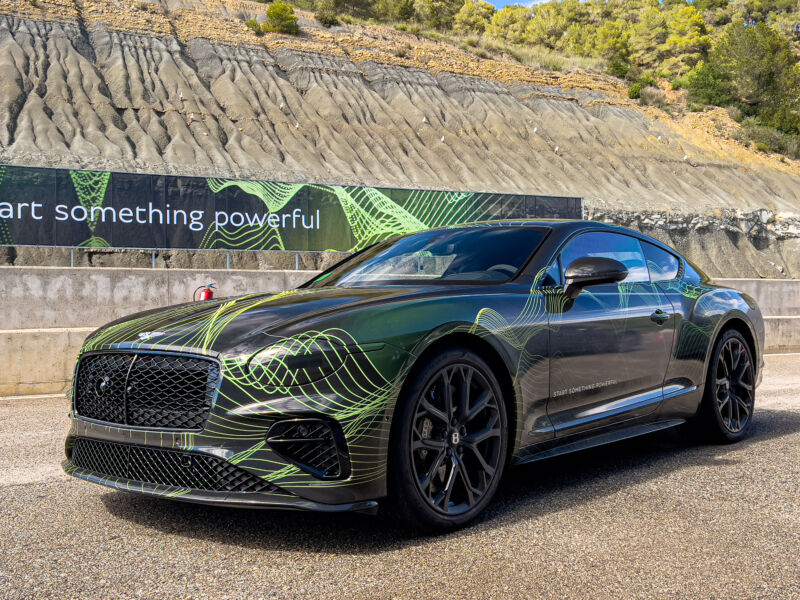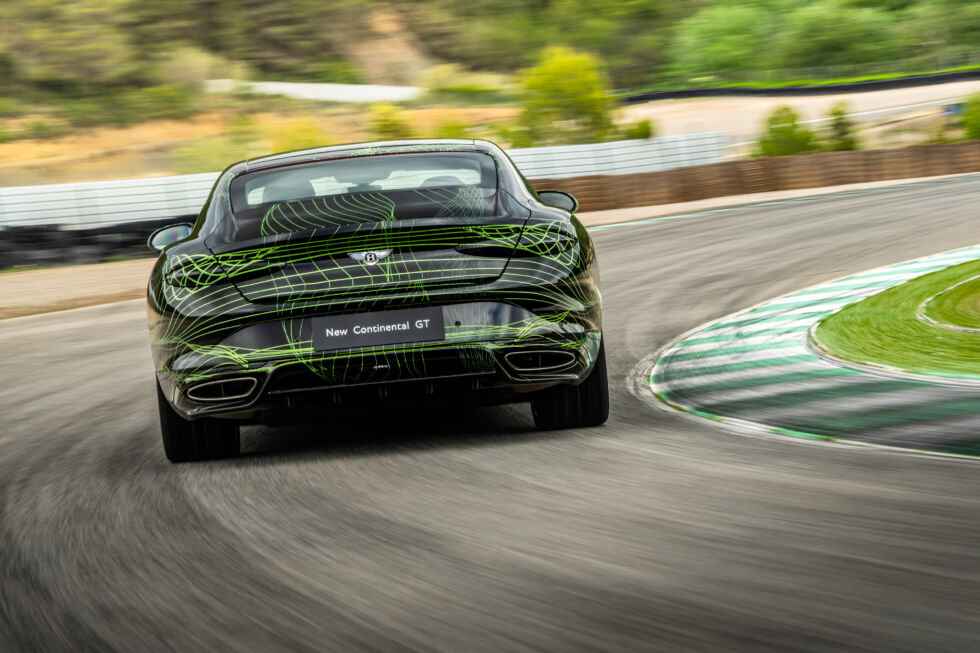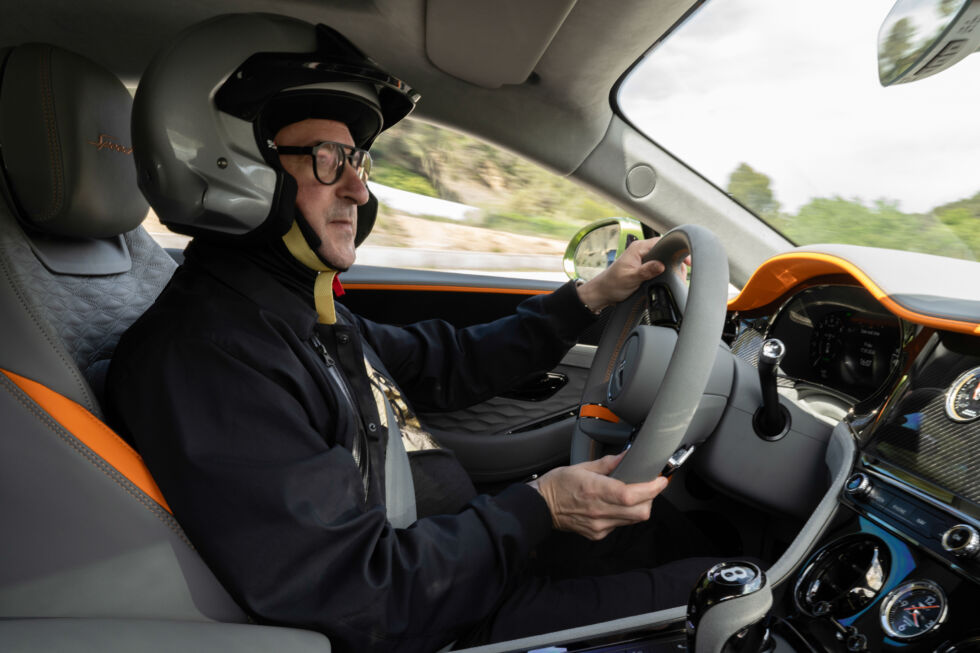Plug-in hybrid powertrain perfectly suits Bentley’s next Continental GT Speed.

BARCELONA—The days of big engines are numbered, even for big spenders. Owning a GT that lets you drive across Europe in a day in cosseted luxury means very little if you’re not allowed to drive it into the city you’re meant to be visiting, after all. Low emissions zones are either a fact of life or on the way in many of the more desirable urban postcodes, and even here in the US, we’re about to start getting quite tough on fuel efficiency. Which is why Bentley is saying goodbye to its W12-powered Continental GT Speed and replacing it with a new plug-in hybrid instead.
The W12 engine has become something of a trademark for Bentley in the 21st century. For many years, Bentleys were essentially just badge-engineered Rolls-Royces, while both companies were owned by the aircraft maker Vickers. But VW group took control of Bentley in 1998—BMW got Rolls-Royce—and it was time for something fresh.
Originally developed within parent company Volkswagen Group for use in the all-aluminum Audi A8, the W12 design essentially mated a pair of narrow-angle V6 engines as used in the Golf VR6 to create a compact and powerful multi-cylinder engine for those customers looking for a powertrain a bit less common than a V8.

The first W12-powered Bentley was the Continental GT, a car that took inspiration from Bentley’s archives to create a thoroughly modern two-door coupe capable of carrying four adults at up to 200 mph (321 km/h). That car debuted in 2003, and since then, the Continental GT has proven to be a hit—the company has sold almost 100,000 so far.
Bentley aspires to become the world’s most sustainable luxury automaker, investing in a new paint shop and other improvements at its factory in Crewe, England, to help make that happen. Switching the Continental GT Speed over to a plug-in powertrain is another step, and the company is proud of achieving a WLTP rating of 36 g/CO2 per mile for the new car.
While the plug-in hybrid powertrain is new to Bentley, we have already encountered this mix of turbocharged 4.0 L V8 and electric motor in the new Porsche Panamera. (Yes, in the 21st century, Bentley still has to share toys with its stablemates.) Combined output is a gigantic 771 hp (575 kW) and 737 lb-ft (1,000 Nm), capable of hurling this Bentley from a standstill to 62 mph (100 km/h) in just 3.2 seconds. Power and torque go to all four wheels via an eight-speed dual-clutch transmission.
On its own, the V8—which uses single-scroll turbochargers for each bank of its V—generates 584 hp (435 kW) and 590 lb-ft (800 Nm). The electric motor, which is mounted between the engine and the dual-clutch transmission, contributes 188 hp (140 kW) and up to 332 lb-ft (450 Nm). The lithium-ion traction battery in the GT Speed has the same 25.9 kWh capacity as the Panamera’s pack, and here it lives above the rear axle for better weight distribution.

Bentley isn’t ready to show off the fourth-generation Continental GT until late June, so I’m not allowed to tell you anything about the way it looks when not covered in camo wrap until then. The fact that the cars were still prototypes explains why we weren’t allowed to drive them on the road either—just on the circuit at Castelloli, a rather interesting track with 12 corners, plenty of elevation change, and even a crossover.
ARS VIDEO
What Happens to the Developers When AI Can Code? | Ars Frontiers
Taking it for a spin
Now, Bentley has competed with the Continental GT a few times here and there. It set an ice speed record in 2007 and a production car record at Pikes Peak in 2019. There have even been Bentley Continental GT3 race cars, including one that triumphed at Australia’s intimidating Mount Panorama circuit in Bathurst. But those are the exceptions, and since few Bentley GT drivers will take their cars on track, but all will drive them on the road, I used my time on the circuit to try to get an idea of what driving this big bruiser will be like.
When you start up the car, it defaults to just using the electric motor, and the GT Speed is happy to leave the V8 to snooze unless you ask for more than 70 percent throttle or your speed has crept up past 100 mph (160 km/h). We weren’t provided with a curb weight, but it’s somewhere in the region of 5,000 lbs (2,267 kg). Yet, the electric motor had more than enough torque to move the GT Speed off the line briskly, and I could happily spend all day in this mode, particularly in built-up settings, without ever missing the extra power.
At least until the battery runs out. Bentley told us it should have 50 miles (80 km) of electric-only range, which I’m pretty sure will be the European WLTP range; EPA electric-only range may be a little less. Recharging takes less than three hours with a level 2 charger, and there are also powertrain modes that will hold the battery at a specified state of charge and another that will recharge the battery pack using power from the V8.

After a sighting lap under silent electric propulsion, it was time to floor the throttle, wake the engine, and experience the full symphony in action. In Sport mode, there was a very bassy, if slightly distant, V8 rumble from somewhere behind me, as well as some exhaust burbling on part-throttle. The steering was relatively communicative, mostly telling me that lots of the track had very little grip due to several hours of torrential rain that had only just begun to abate as I got in the car.Advertisement
Intentionally provoking a loss of traction at the rear proved easy to correct. With a little more time, lurid power slides may well have proved possible, at least in Sport mode, which relaxes the electronic nanny that watches over the driver, trying to keep them pointed in the right direction. Sport mode gives you a firmer ride than Bentley mode and keeps the engine running the whole time; Bentley mode will let you run on electric power whenever it makes sense. The Bentley and Sport modes have noticeably different driving manners, too, in part thanks to 48 V active roll bars front and rear, together with air springs and two-valve dampers.
As the prodigious power output would suggest, this is a car that gains speed quite quickly. Even driving at only 60 percent, I saw about 120 mph (193 km/h) on the digital dashboard display before braking for turn six. Braking often exposes a heavy (but powerful) car’s real weight, but the GT Speed was more than up to the job, with 10-piston calipers up front. Like the steering, the brake pedal was not devoid of feel despite being a brake-by-wire system.
On June 25, Bentley will reveal the undisguised Continental GT Speed. As for a fully electric Bentley, it will arrive in 2026 when the Bentayga moves over to VW Group’s Premium Platform Electric (also used by Audi and Porsche).




